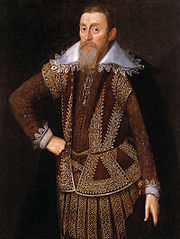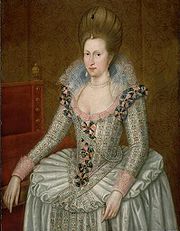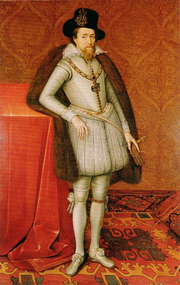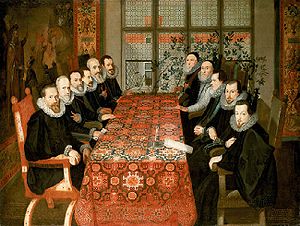
John de Critz
Encyclopedia

London
London is the capital city of :England and the :United Kingdom, the largest metropolitan area in the United Kingdom, and the largest urban zone in the European Union by most measures. Located on the River Thames, London has been a major settlement for two millennia, its history going back to its...
) was one of a number of painters of Flemish and Dutch origin active at the English royal court during the reigns of James I of England
James I of England
James VI and I was King of Scots as James VI from 24 July 1567 and King of England and Ireland as James I from the union of the English and Scottish crowns on 24 March 1603...
and Charles I of England
Charles I of England
Charles I was King of England, King of Scotland, and King of Ireland from 27 March 1625 until his execution in 1649. Charles engaged in a struggle for power with the Parliament of England, attempting to obtain royal revenue whilst Parliament sought to curb his Royal prerogative which Charles...
. He held the post of Serjeant Painter
Serjeant Painter
The Serjeant Painter was an honorable and lucrative position with the British monarchy. It carried with it the prerogative of painting and gilding all of the King's residences, coaches, banners, etc. and it grossed over £ 1,000 in a good year by the 18th century...
to the king from 1603, at first jointly with Leonard Fryer and from 1610 jointly with Robert Peake the Elder
Robert Peake the Elder
Robert Peake the Elder was an English painter active in the later part of Elizabeth I's reign and for most of the reign of James I. In 1604, he was appointed picture maker to the heir to the throne, Prince Henry; and in 1607, serjeant-painter to King James I – a post he shared with John De Critz...
.
De Critz's Flemish parents brought him as a boy to England from Antwerp, during the Habsburg
Habsburg
The House of Habsburg , also found as Hapsburg, and also known as House of Austria is one of the most important royal houses of Europe and is best known for being an origin of all of the formally elected Holy Roman Emperors between 1438 and 1740, as well as rulers of the Austrian Empire and...
persecution of Dutch Protestants, and apprenticed him to the artist and poet Lucas de Heere
Lucas de Heere
Lucas de Heere was a Flemish portrait painter, poet and writer.De Heere was a Protestant and became a refugee from the Dutch Revolt against Philip II of Spain, who tried to suppress Protestantism...
, also from Antwerp, who may have taught members of the Gheeraerts
Marcus Gheeraerts the Younger
Marcus Gheeraerts was an artist of the Tudor court, described as "the most important artist of quality to work in England in large-scale between Eworth and Van Dyck" He was brought to England as a child by his father Marcus Gheeraerts the Elder, also a painter...
family and Robert Peake
Robert Peake the Elder
Robert Peake the Elder was an English painter active in the later part of Elizabeth I's reign and for most of the reign of James I. In 1604, he was appointed picture maker to the heir to the throne, Prince Henry; and in 1607, serjeant-painter to King James I – a post he shared with John De Critz...
as well. De Critz established himself as an independent artist by the late 1590s,
and in 1603 he was appointed serjeant-painter to the king.
De Critz's work, traced through his bills, also entailed the restoration of decorative detail, the painting and guilding of royal coaches and barges, and individual tasks such as painting the signs and letters on a royal sun-dial. He also painted "bravely" for court masques, dramatic spectaculars which required elaborate scenery and scenic effects.
Family
De Critz's father was Troilus de Critz, a goldsmithGoldsmith
A goldsmith is a metalworker who specializes in working with gold and other precious metals. Since ancient times the techniques of a goldsmith have evolved very little in order to produce items of jewelry of quality standards. In modern times actual goldsmiths are rare...
from Antwerp. John de Critz's sister Magdalena married Marcus Gheeraerts the Younger
Marcus Gheeraerts the Younger
Marcus Gheeraerts was an artist of the Tudor court, described as "the most important artist of quality to work in England in large-scale between Eworth and Van Dyck" He was brought to England as a child by his father Marcus Gheeraerts the Elder, also a painter...
, another Flemish court painter, who may also have been a pupil of de Heere. De Critz was succeeded as Serjeant Painter by his son John the Younger (b. before 1599), who had been involved in the work for many years—his father died at about 90. John the Younger was killed shortly afterwards in the fighting at Oxford. Other painters from the family include John the Elder's sons Emmanuel (1608-65), who also worked for the court, and Thomas (1607-53), to whom many portraits of their Tradescant
John Tradescant the elder
John Tradescant the elder , father of John Tradescant the younger, was an English naturalist, gardener, collector and traveller, probably born in Suffolk, England...
relations are now attributed. Thomas also worked for the Crown between 1629 and 1637. Oliver de Critz (1626-51) was a son of John the Younger by his third wife; his portrait in the Ashmolean Museum
Ashmolean Museum
The Ashmolean Museum on Beaumont Street, Oxford, England, is the world's first university museum...
may be a self-portrait.
Serjeant Painter
The post of serjeant-painter came into being with the appointment of John Browne in 1511–12, and the last known holder was James Stewart, of whom no records are available after 1782, though it is not clear whether the post was ever actually abolished. In a patent issued on 7 May 1679 for Robert StreaterRobert Streater
Robert Streater , was an English landscape, history, still-life and portrait artist, architectural painter, and etcher...
, a list of previous serjeant-painters is given, including "John Decreetz & Robert Peake" as joint-holders of the post. De Critz was given the post in 1603 but is first described as sharing the office with Leonard Fryer, who had held it since 1595. Robert Peake the Elder
Robert Peake the Elder
Robert Peake the Elder was an English painter active in the later part of Elizabeth I's reign and for most of the reign of James I. In 1604, he was appointed picture maker to the heir to the throne, Prince Henry; and in 1607, serjeant-painter to King James I – a post he shared with John De Critz...
was appointed jointly with de Critz in 1607, or 1610. A payment made to de Critz in 1633 shows that he was paid a retainer of £40 a year.

Royal Collection
The Royal Collection is the art collection of the British Royal Family. It is property of the monarch as sovereign, but is held in trust for her successors and the nation. It contains over 7,000 paintings, 40,000 watercolours and drawings, and about 150,000 old master prints, as well as historical...
, and many decorative tasks, for example scene painting and the painting of banners.
Horace Walpole provided information about some of the tasks de Critz performed in his Anecdotes of Painting in England, which he based closely on the notes of George Vertue
George Vertue
George Vertue was an English engraver and antiquary, whose notebooks on British art of the first half of the 18th century are a valuable source for the period.-Life:...
, who had met acquaintances of de Critz and his family. In particular, Walpole quoted from a scrap of paper, a "memorandum in his own hand", on which de Critz wrote bills for jobs completed. On one side was his bill for work on a sun-dial:
For several times oyling and laying with fayre white a stone for a sun-dyall opposite to some part of the king and queen’s lodgings, the lines thereof being drawn in severall colours, the letters directing to the bowers guilded with fine gould, as alsoe the glory, and a scrowle guilded with fine gould, whereon the number and figures specifying the planetary howers are inscribed; likewise certain letters drawne in black informing in what part of the compasse the sun at any time there shining shall be resident; the whole worke being circumferenced with a frett painted in a manner of a stone one, the compleat measure of the whole being six foote.
On the other side is a demand for payment for work on the royal barge:
John De Critz demaundeth allowance for these parcells of Worke following, viz. For repayreing, refreshing, washing and varnishing the whole body of his Majesty’s privy barge, and mending with fine gould and faire colours many and divers parts thereof, as about the chaire of state, the doores, and most of the antiques about the windowes, that had bene galled and defaced, the two figures at the entrance being most new coloured and painted, the Mercury and the lion that are fixed to the sternes of this and the row barge being in several places repayred both with gould and colours, as also the taffarils on the top of the barge in many parts guilded and strowed with fayre byse. The two figures of Justice and Fortitude most an end [sic] being quite new painted and guilded. The border on the outside of the bulk being new layd with faire white and trayled over with greene according to the custom heretofore—and for baying and colouring the whole number of the oares for the row barge being thirty-six.
Walpole also noted that de Critz painted a gilded "middle piece" for a ceiling at Oatlands Palace
Oatlands Palace
Oatlands Palace is a former Tudor and Stuart royal palace located between Weybridge and Walton on Thames in Surrey, England. The surrounding modern district of Oatlands takes its name from the palace...
and repaired pictures, and he quoted a wardrobe account for work on the royal carriages: "To John De Critz, serjeant-painter, for painting and gilding with good gold the body and carriages of two coaches and the carriage of one chariot and other necessaries, 179l.3s.4d. anno 1634." De Critz also gilded Maximilian Colt's
Maximilian Colt
Maximilian Colt was a Flemish sculptor who settled in England and eventually rose to become the King's Master Carver....
marble effigy for the tomb of Elizabeth I
Elizabeth I of England
Elizabeth I was queen regnant of England and Ireland from 17 November 1558 until her death. Sometimes called The Virgin Queen, Gloriana, or Good Queen Bess, Elizabeth was the fifth and last monarch of the Tudor dynasty...
, completed in 1606, which had been painted by Nicholas Hilliard
Nicholas Hilliard
Nicholas Hilliard was an English goldsmith and limner best known for his portrait miniatures of members of the courts of Elizabeth I and James I of England. He mostly painted small oval miniatures, but also some larger cabinet miniatures, up to about ten inches tall, and at least two famous...
. All traces of the painting and gilding have now disappeared.
Walpole said of de Critz that "His life is to be collected rather from office-books than from his works or his reputation"; and the comparative mundanity of some of the tasks he undertook has led to a downplaying of the artistic role of the serjeant-painter. Art historian William Gaunt describes de Critz's role as "mainly that of a handyman". A Burlington Magazine editorial remarked:
A great deal of easy fun has been poked at the institution of the serjeant-painters, because these had to attend to tasks such as downright house-painting, the painting of barges and coaches, the provision of banners and streamers, and so on.
Life and work

St Martin-in-the-Fields
St Martin-in-the-Fields is an Anglican church at the north-east corner of Trafalgar Square in the City of Westminster, London. Its patron is Saint Martin of Tours.-Roman era:Excavations at the site in 2006 led to the discovery of a grave dated about 410...
before his death in 1642. He stated in his will that he had previously lived for thirty years in the parish of St Andrew, Holborn
St Andrew, Holborn
St Andrew, Holborn is a Church of England church on the northwestern edge of the City of London, on Holborn within the Ward of Farringdon Without.-Roman and medieval:Roman pottery was found on the site during 2001/02 excavations in the crypt...
. Horace Walpole notes George Vertue's comment that there were three rooms full of the king’s pictures at de Critz’s house in Austin-friars. De Critz is entered in a subsidy roll for the parish of St Sepulchre-without-Newgate
St Sepulchre-without-Newgate
St Sepulchre-without-Newgate, also known as the Church of the Holy Sepulchre , is an Anglican church in the City of London. It is located on Holborn Viaduct, almost opposite the Old Bailey...
in 1607 and again in 1625; and since this parish adjoins St Andrew, Holborn, he possibly had his studio in St Sepulchre.
Although de Critz was a prolific painter, few of his works have been clearly identified. The portrait painters of the Elizabethan and Jacobean period present peculiar difficulties in this respect, since they often made multiple versions not only of their own paintings but of those of their predecessors and contemporaries, and they rarely signed their work. In addition, portraits by different artists often share poses or iconographical features. Although many paintings are attributed to de Critz, therefore, full authentication is unusual. The noted art historian and critic Sir John Rothenstein
John Rothenstein
Sir John Knewstub Maurice Rothenstein CBE was an English art historian. He grew up in London the son of Sir William Rothenstein. The family was loosely connected to the Bloomsbury Set. John Rothenstein studied at Oxford University and became friends with T. E. Lawrence...
summed up the problems:
To make definitive attributions is a difficult undertaking. This is due to a variety of causes, the most important being the practice of successful painters of employing assistants. Another confusing factor is the tendency on the part of members of the artistic families to intermarry with one another; Marc Gheeraerts the elder and his son and namesake, for example, both married sisters of John de Critz. Similarities of style were also encouraged by legislation, and painters were for a time forbidden to portray the Queen pending the painting of a portrait such as might be taken as a model to be copied.

Somerset House
Somerset House is a large building situated on the south side of the Strand in central London, England, overlooking the River Thames, just east of Waterloo Bridge. The central block of the Neoclassical building, the outstanding project of the architect Sir William Chambers, dates from 1776–96. It...
, when diplomatic exchanges of miniatures and full-length portraits took place in a sustained show of brilliant self-representation. In this context, Ungerer discusses the contested authorship of the famous painting of the two sets of negotiators sitting opposite each other at the conference table, The Somerset House Conference, a work in which John de Critz may have had a hand, either directly or as a source for the copying of figures.
.jpg)
National Maritime Museum
The National Maritime Museum in Greenwich, England is the leading maritime museum of the United Kingdom and may be the largest museum of its kind in the world. The historic buildings forming part of the Maritime Greenwich World Heritage Site, it also incorporates the Royal Observatory, Greenwich,...
, Greenwich—are signed by the Spanish court painter Juan Pantoja de la Cruz
Juan Pantoja de la Cruz
Juan Pantoja de La Cruz Spanish painter, one of the best representatives of the Spanish school of court painters. He worked for Philip II and Philip III. The Museo del Prado contains examples of his severe portraiture style.- Life :Juan Pantoja de La Cruz was, born 1553 in Valladolid...
; but scholars disagree about whether he was in fact the artist since, although the signatures appear authentic, he was never in London. It is possible that either the works are by a Flemish artist, possibly Frans Pourbus
Frans Pourbus the younger
Frans Pourbus the younger was a Flemish painter, son of Frans Pourbus the Elder and grandson of Pieter Pourbus. He was born in Antwerp and died in Paris...
, or John De Critz, or were copied by Pantoja from a Flemish artist who was in London at the time. Pantoja may have worked up the likenesses of the English negotiators by "copying the faces of the delegates either from miniatures or from standard portraits given to him or to the constable in London or sent to Valladolid...He obviously used a Cecil portrait as model for The Somerset House Conference which was Cecil's standard type of portrait attributed to John de Critz". It is certainly on record that the leader of the English negotiating team, Sir Robert Cecil
Robert Cecil, 1st Earl of Salisbury
Robert Cecil, 1st Earl of Salisbury, KG, PC was an English administrator and politician.-Life:He was the son of William Cecil, 1st Baron Burghley and Mildred Cooke...
, gave the leader of the Spanish negotiators, Juan Fernández de Velasco, 5th Duke of Frías
Juan Fernández de Velasco, 5th Duke of Frias
Juan Fernández de Velasco, 5th Duke of Frías was a Spanish nobleman and diplomat.Juan Fernández de Velasco was the son of Íñigo Fernández de Velasco; and of Maria Angela de Aragón y Guzmán El Bueno. He inherited his father's title of Constable of Castile, and was present at the signing of the...
and Constable of Castile, his stock portrait as duplicated in the workshop of John de Critz. Pantoja's depiction of Charles Howard, earl of Nottingham
Charles Howard, 1st Earl of Nottingham
Charles Howard, 1st Earl of Nottingham , known as Howard of Effingham, was an English statesman and Lord High Admiral under Elizabeth I and James I...
, also looks as if it has been duplicated from a standard portrait. Apart from the heads, the picture shows signs of workshop painting by assistants, perhaps revealing that numerous versions were produced, as there would have been many demands from those involved for duplicates of the painting, for purposes of historical record. The painting sheds light on the piecemeal process of constructing group portraits at this time.

